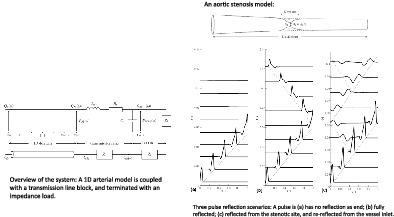当前位置:
X-MOL 学术
›
Int. J. Numer. Method. Biomed. Eng.
›
论文详情
Our official English website, www.x-mol.net, welcomes your
feedback! (Note: you will need to create a separate account there.)
A coupled one dimension and transmission line model for arterial flow simulation.
International Journal for Numerical Methods in Biomedical Engineering ( IF 2.2 ) Pub Date : 2020-03-11 , DOI: 10.1002/cnm.3327 Nathaniel Baker 1 , Richard Clarke 2 , Harvey Ho 3
International Journal for Numerical Methods in Biomedical Engineering ( IF 2.2 ) Pub Date : 2020-03-11 , DOI: 10.1002/cnm.3327 Nathaniel Baker 1 , Richard Clarke 2 , Harvey Ho 3
Affiliation

|
A broad choice of numerical schemes and methods currently exists for blood flow simulations. The results rely critically on the prescription of boundary conditions. The outflow boundary condition for a one‐dimensional (1D) flow solver is usually prescribed via a Windkessel or lumped parameter model. The weakness of such an approach is the determination of the parameters. In the present work, we use an alternative approach, that is, a reflection coefficient (RC), to lumped parameter models for distal boundary conditions. With such a RC, the number of parameters required is reduced to one. We derive the theoretical foundation for the RC. Specifically, we couple a transmission line theory for peripheral resistance with a 1D arterial flow solver. We apply this method to a healthy and a stenosed virtual aorta, and show this method can reproduce some subtle features in arterial pressure propagation, such as the steepened pressure waveform and the reflection from the stenosed site. In summary, the RC parameter has strong physical implications in the theory of wave propagation and may be used in flow simulations where reflections need to be explicitly modeled.
中文翻译:

一维和传输线耦合模型,用于动脉血流模拟。
当前,存在多种用于血流模拟的数值方案和方法。结果主要取决于边界条件的规定。一维(1D)流量求解器的流出边界条件通常是通过Windkessel或集总参数模型指定的。这种方法的缺点是确定参数。在目前的工作中,我们使用一种替代方法,即反射系数(RC),将参数模型集中到远端边界条件。使用这种RC,所需的参数数量减少到一个。我们得出了钢筋混凝土的理论基础。具体来说,我们将用于外围阻力的传输线理论与一维动脉流动求解器结合在一起。我们将此方法应用于健康且狭窄的虚拟主动脉,并表明此方法可以重现动脉压力传播中的一些细微特征,例如变陡的压力波形和狭窄部位的反射。总而言之,RC参数在波传播理论中具有很强的物理意义,可用于需要对反射进行显式建模的流模拟中。
更新日期:2020-03-11
中文翻译:

一维和传输线耦合模型,用于动脉血流模拟。
当前,存在多种用于血流模拟的数值方案和方法。结果主要取决于边界条件的规定。一维(1D)流量求解器的流出边界条件通常是通过Windkessel或集总参数模型指定的。这种方法的缺点是确定参数。在目前的工作中,我们使用一种替代方法,即反射系数(RC),将参数模型集中到远端边界条件。使用这种RC,所需的参数数量减少到一个。我们得出了钢筋混凝土的理论基础。具体来说,我们将用于外围阻力的传输线理论与一维动脉流动求解器结合在一起。我们将此方法应用于健康且狭窄的虚拟主动脉,并表明此方法可以重现动脉压力传播中的一些细微特征,例如变陡的压力波形和狭窄部位的反射。总而言之,RC参数在波传播理论中具有很强的物理意义,可用于需要对反射进行显式建模的流模拟中。











































 京公网安备 11010802027423号
京公网安备 11010802027423号